Chapter 15 Chapter 15 Minority Dances with a Long History
Every nation in the big family of the Chinese nation has its own dance traditions.Most of the dances of various ethnic groups are closely related to their own customs, such as marriage customs and belief customs, and are characterized by simplicity and health.
As early as the early years of the Han Dynasty, there was a "Bayu Dance" by the Ba people.According to related documents, the people of Cong Cong on the waterside of Chongqing in Lang (lang Lang) of Sichuan were brave and good at fighting.They also like to dance very much, and the dancing utensils they use are "banchuang" used in combat.Emperor Gaozu of the Han Dynasty taught musicians to learn this dance, and named it "Bayu Dance".The banyan evolved into a kind of drum called "鞞〔bingbing〕".Therefore, the Bayu Dance is also called "Ban Fan Dance", and it was performed in the Northern and Southern Dynasties.
The dances of various ethnic groups in the four regions of China communicated with the dances of the Central Plains very early.During the Wei, Jin, Southern and Northern Dynasties, a large number of Hu Yue and Hu Wu flooded into the Central Plains, so the "Seven Music" was produced in the Sui Dynasty, and it was summarized into "Ten Music" in the Tang Dynasty.
In the Song Dynasty, China produced an official philosophy—Confucianism (also known as "Taoism"). Due to the rule of Confucianism, the dance of the Han people was greatly restrained. Minorities living in remote areas were less affected by feudal ethics. Influence. The dance art of ethnic minorities also maintains more innocent and simple national characteristics, and has been passed down to modern times with its unique style.
Xinjiang has been the hometown of singing and dancing since ancient times.Uighurs and other nationalities have created splendid dance cultures during the Sui and Tang dynasties.More than 1,300 years ago, when Hai Zezi invented Rewafu and Tanbul, Uighur compatriots created a large-scale music and dance "Muqam".Until the Ming and Qing Dynasties, Uighur artists were still engaged in the creation of "Muqam", so "Twelve Muqam" has been handed down to this day.
In the 1271 year of the Islamic calendar (1854 A.D., the fourth year of Xianfeng in the Qing Dynasty), Mullah Ismutura of Hotan, Xinjiang wrote a book "A Brief History of Artists".The book introduces and praises 17 outstanding artists.Most of these artists were active between 800 and 900 in the Muslim calendar (equivalent to 1383-1483 A.D., from Hongwu to Chenghua in the Ming Dynasty).Five or six hundred years ago, these artistic geniuses among the brotherly ethnic groups in Xinjiang were mostly writers, poets, composers, performers, singers, music theorists, and inventors of musical instruments.Many musicians mentioned in the book have created many "Muqam".
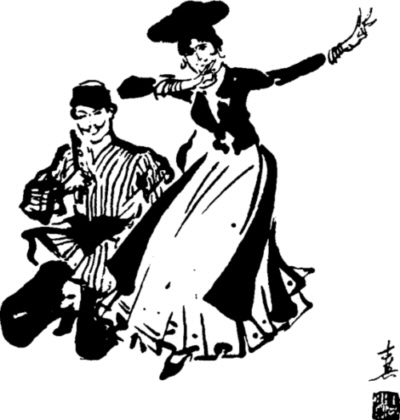
Figure 52 Xinjiang Uyghur Dance
"Muqam" is similar to "Daqu" in Tang Dynasty.It is divided into three parts: prose, narrative song group and song and dance.Take "Daolang Muqam" as an example, the first song is a melodious and high-pitched Sanban solo; the second song "Chechtman" is a steady adagio, with a chorus, and dancers are invited to dance one by one ; The third song "Sainaim" is a medium-speed dance music, performing a double dance while walking and turning; the fourth song "Knex" is a dance music with clear rhythm and enthusiasm, and everyone dances in a circle; the fifth song "Sai Liman" is an allegro dance music, spinning dance, the emotion reaches a climax, and finally ends in a rapid rotation on the spot.This is a song and dance created by the "Daolang" people who lived on the edge of the Tarim Desert in ancient times, from which we can roughly imagine the style and appearance of the "Hu Xuan" dance in the Tang Dynasty. The scale of "Muqam" is magnificent, and the performance of "Twelve Muqam" will take more than 20 hours.
The ancestors of the Tibetans were called "Tubo" in the Tang Dynasty.The relationship between the Han and Tibetan ethnic groups is very close.In the Tang Dynasty, Princess Wencheng married Tubo Zamp Songtsen Gampo, which is a good story of national unity.In Cave 156 of the Mogao Grottoes in Dunhuang, there is a mural "Zhang Yichao's Traveling Picture" and a "Mrs. Song Traveling Picture" from the late Tang Dynasty.In the picture, there are male and female dancers performing in the guard of honor.Their dancing postures are very characteristic of Tibetan dances.
Tibetan compatriots are good at singing and dancing, and their folk dance heritage is very rich.Famous Tibetan dances include "Guozhuang Dance", "Xianzi Dance", "Reba", "Nangma" and so on. "Guozhuang Dance", also called "Zhuo", is a song and dance with rich content and various styles.Some have a slow rhythm and a stretched dance; some have a fast rhythm and are fierce and unrestrained. Many of the movements in "Zhuo" imitate the forms of animals, such as "the tiger descending the mountain", "the eagle spreads its wings", etc., which are related to the local scenery of Tibet and the ancient hunting life. "Zhuo" has a dance where women hold hands, and there is also a dance where men and women love each other and hold hands.Later, "Guozhuang" was designated as a sacrificial dance.According to legend, the Dalai Lama already had "Guozhuang", which shows that its history is at least five or six hundred years old.Tibetans also have "Xianzi Dance", also known as "Xie".A man plays the strings and leads the dance, and a group of people follow behind and form a circle to sing and dance.The singing is melodious, the dancing sleeves are fluttering, and the style is beautiful and soft.In addition, there is a kind of tap dance with vigorous dancing posture and cheerful mood, which Tibetans call "Dui Harmony".

Figure 53 "Zhuo" dancing posture
"Reba" is a comprehensive Tibetan folk performance that integrates singing, dancing, rap and acrobatics.It uses bells and drums as the main form of performance, and is also known as "bell drums".According to the artist, "Reba" was produced around the 11th century.There are many professional "reba" artists among the Tibetan people, who perform mobile performances.
Most Tibetan people believe in Tibetan Buddhism.There is a religious ritual dance in the temple, called "Qiangmu".Accompanied by drums, cymbals, bronze horns, bone horns, suona, etc., some programs are accompanied by lamas chanting.Use masks to play gods. The "Qiangmu" mask is vivid in shape and fine in workmanship, reflecting the religious belief and rich imagination of the Tibetan people.

Figure 54 "Reba" dancing posture
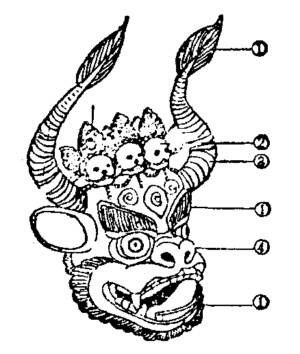
①Gold ②White ③Black ④Red Nixie
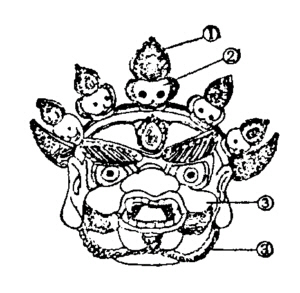
①Gold-plated ②White ③Red ④Gold-plated Russian one Figure 55 Example of "Qiangmu" mask

Figure 56 Example of "Qiangmu" dance posture
It is a custom in Tibet that on the 15th day of the fourth month in the Tibetan calendar every year, "Nangma" is performed at the Dragon King Pond behind the Potala Palace. "Nangma" was first popular in the upper class of Tibet.It is said that "Nangma" originally did not have dances, but only sang the lyric poems written by the sixth Dalai Lama.It was not until the eighth Dalai Lama returned to Tibet from the mainland that dances were added to Nangma.After the Ninth Dalai Lama, "Nangma" fell into disuse for a while.During the time of the 12th Dalai Lama, due to the advocacy of some Hui compatriots, "Nangma" became popular again in Lhasa.Fans of "Nangma" in Lhasa gather every night, go around the Bajiao Street, and finally go to the Jokhang Temple to sing and dance in a circle.
Most of the Mongolian dances are powerful and majestic, but there are also lyrical and graceful dances.The famous "Sixteen Heavenly Demon Dance" was performed in the court of the Yuan Dynasty, while "Dao La" was circulated among the people.According to the description of people in the Qing Dynasty, during the performance of "Dao La", the music was played first, and the dancers danced with the music.The rhythm of the music is getting faster and faster, and the dancers are twirling like the wind returning to the snow.Artists "separate the tops of the double owls, light the lamps on the tops, and hold Xiangzhu in their mouths, and the festival is audible".From the current Mongolian "Lantern Dance" and "Cup and Bowl Dance", it is not difficult to find the legacy of "Dao La".
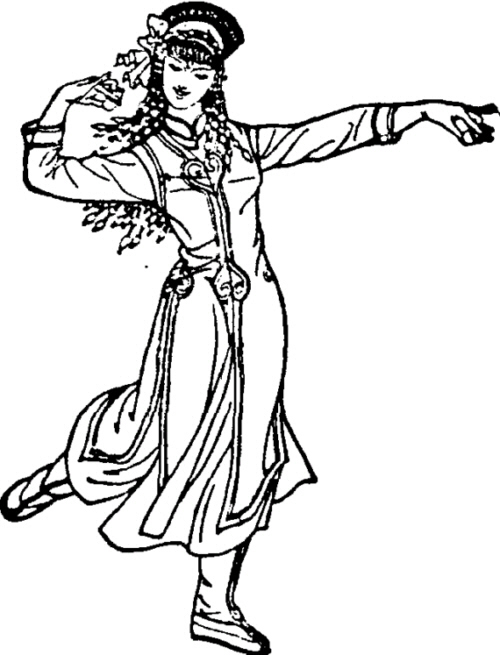
Figure 57 Cup and Bowl Dance
"Andai" is an ancient Mongolian group dance that has been spread on the Horqin Grassland.It was originally a song and dance performed by shamans to heal infertile or lovesick women.Later, it developed into a collective song and dance performance with a large number of people.There is no distinction between spectators and dancers, as long as the Andai venue is set up, people can enter the venue holding handkerchiefs or lifting the hem of Mongolian robes to enjoy singing and dancing.The dance is characterized by various towel throwing, stamping, stepping and circle formations.Andeido takes place between late summer and autumn harvest.Generally jump from dusk to late night, even all night long.Usually, an antidote can last for as little as seven days, as long as 21 days, and as long as 40 days.The number of participants ranges from 30 to 50, and some as many as hundreds.Andai's host is "Bo" (shaman wizard).
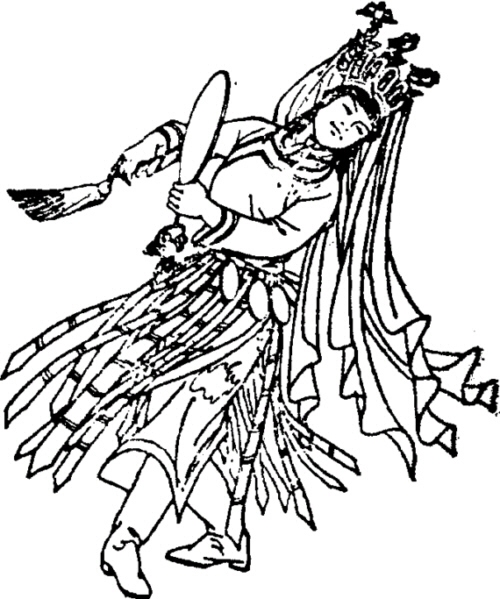
Figure 58 "Bo"
The Mongolians also have a religious dance called "Chama", also known as "Fighting Ghosts".It is a dance taught by Lamas.People who believe in Lamaism believe that "fighting ghosts" during the first month of the year can bless peace. During the performance of "Chama", they all wore masks.Take the deer god as the main character.Some masks have five skulls on the head of a bull.In addition, there are more than 30 kinds of masks such as King Kong, Heavenly King, Lion, Eagle, Monkey, Phoenix, and Butterfly.During the performance, the band played drums, trumpet and sheep horn, and swayed Dharma bells, vajra and other instruments, creating a warm and mysterious atmosphere.It is said that this dance was learned from Tibetan lamas, and then spread to various monasteries.

Figure 59 "Chama" dancing posture
The ancient Mongolian folk dances include "Chopsticks Dance", "Plate Dance", "Zheren Hey" (Dancing Yellow Sheep Circle), "Lantern Dance", "Dance of Twelve Zodiac Signs", "Eri Moche Dance" ", "Naruo Kajidema" and so on, as well as various "Bo" dances performed by "Bo" dancing gods, offering sacrifices to heaven, earth, tree, Obo, and fire.

Figure 61 Eri Moche
The ancestors of the Manchus originally lived in Northeast China.In ancient Manchu banquets, the hostess and the hostess must take turns to dance. The movement is "raise one sleeve to the forehead, turn the other sleeve to the back, and circle around".This kind of dance is called "Mang Style". "Mang Style" was very popular in the Qing Dynasty.After it was introduced to the court, not only the kings and ministers wanted to dance "Mang Style", but even Emperor Kangxi once skipped "Mang Style" on Empress Xiaohuizhang's 70th birthday.According to the "Donghai Mang Style General Ge Jue" handed down from ancient times, we know that "Donghai Mang Style" is a large-scale Manchu group dance.The content is divided into 10% off: starting pose, needle threading, swinging water, auspicious step, single galloping horse, double galloping horse, coiling dragon, reckless monster out of hole, big round field.Manchu also has a "savage dance", called "Balamang style", which is performed during the grand ceremony of worshiping the sacred tree.This is a large-scale group dance that expresses the love and marriage customs of the Bala people who lived in the deep mountains and forests in ancient times.The performance is divided into five sections.The performers should wear their hair loose and wear leopard skin skirts and willow leaf skirts.This is the most primitive dance among the Manchu people.
"Yang Lie Dance" is one of the traditional dances that expresses the life of Manchu riding and archery. It is divided into five sections: looking from afar, tracking, walking around, performing martial arts and hunting. There are more than 20 movements such as ringing arrows and dancing knives.During the performance, one person walks on stilts and rides a fake horse, and the other wears black leather and paints his face to pretend to be a beast.There is also a dustpan with red oil, scraping the dustpan with chopsticks and singing.It turned out that the samurai on stilts shot the beast to death.
"Shaman Dance" and "Hand Inspiration" are dances performed by shamans who believe in the Manchus when they dance to the gods.
The Yao people living in Southwest and Central South China have an ancient custom.During the Chinese New Year, "Panhu" (Pangu) will be sacrificed, and in October, "Dubai King" will be sacrificed.Dance "Long Drum Dance" when offering sacrifices to the gods.Men and women gather in groups and dance hand in hand.In the process of dancing, young people choose their partners and marry themselves.The "long drum" used by the Yao people is hollow and thin.Both ends are thick and covered with drum skin.There are two kinds of long and short.When dancing, hold the middle of the small long drum horizontally with the left hand, turn it up and down and dance, and then beat the drum surface with the right hand.There are also men who hold the big long drum in front of their body and dance while beating with both hands.The Yao nationality's "Long Drum" originated very early, and it has been described in the notes of people in the Song Dynasty.
The Miao nationality is an ancient ethnic group in southern China.At the latest in the Jin Dynasty, the Miao people already had the "Star Dance".Ming and Qing Dynasties still spread.Robin is the "starling".Covered in black, it can imitate human speech.
The most representative dance of the Miao nationality is the Lusheng Dance.Lusheng is a special wind instrument, which has three types: large, medium and small.There is a picture of Lusheng dancing in "Guangyu Shenglan" written by people in the Qing Dynasty.The painting shows a Miao man playing a sheng and leading the dance, a woman waving a towel in her left hand and dancing with a bell in her right hand.This was a way of performing "Lusheng Dance" at that time.Later, the form of performance developed.Every festival, the Miao compatriots dance the "Lusheng Dance".Sometimes dozens of people, sometimes hundreds of people.Form a circle, each holding a Lusheng, playing and dancing.Sometimes there are also competitive performances by two Lusheng teams or two Lusheng players.
The Yi nationality is also an ancient nation living in the southwest region.There are dances in the wedding and funeral ceremonies and sacrificial activities of the Yi people.Some scholars have divided them into 10 types according to their forms and functions: there are "Suniqie", which are used to invite gods to heal diseases, and "Zi'eqie", which are used for funerals (including "Dieweizi" for welcoming guests, "Wazihe" for mourning, "Aguge" and "Zagge" for guiding the soul of the deceased, "Zhizisuqi" for toasting), "Guoduo" for funerals, and "Fire Dance" for funerals , the felt dance "Xixi Suqi" for weddings, the women's collective dance "Duhuo" during the torch festival, the self-entertaining opposite-foot dance "Da Kick", and the self-entertaining dance "Gu Chai", which expresses the spirit of war. Tiecha dance "Shejieqi" and buckwheat dance "Geziqi" expresses farming.
The Qiang people are one of the oldest ethnic groups in China.The Qiang people have singing and dancing on all festivals, welcoming and seeing off guests, offering sacrifices, weddings and funerals. "Sarang" and "Yo coarse cloth" are self-entertaining songs and dances for festive activities. "Buzila" is the sheepskin drum, which is a sacrificial dance performed by the wizards of the Qiang nationality. "Barong" is an ancient welcome dance, and "Kesigla" and "Hari" are military dances.The dance of the Qiang nationality is mainly based on leg movements, with shouting as the rhythm, or singing and dancing, showing the ancient dance style.

Figure 62 "Lusheng Dance" of the Miao Nationality in the Qing Dynasty (taken from "Guangyu Shenglan")
The Zhuang nationality is the largest ethnic group in China except the Han nationality.The ancestors of the Zhuang nationality had an ancient musical instrument called "Bronze Drum".There are world-famous Huashan cliff paintings in Guangxi, in which there are dancing scenes and bronze drums.The bronze drums unearthed from the Luobowan Han Tomb in Guixian County and the Putuo Han Tomb in Xilin County, Guangxi Guangxi, have a group of dancers wearing feather ornaments on their heads and with their arms outstretched or akimbo.It shows that the dance accompanied by the bronze drum of the Zhuang nationality has a long history.

Figure 63 "Suniqie"
The bronze drum is a symbol of wealth and authority of the Zhuang people.It can be used as a musical instrument for "drumming the crowd" and as an accompaniment for mass dances. "Sui Shu·Geography Records" records that when the bronze drums of the Lingnan ethnic group were newly cast, they were hung in the yard, and wine was served to greet the same ethnic group.The children of the rich and powerful who attended the banquet beat the bronze drum with a big hairpin made of gold and silver, and left the hairpin to the host after the beating, called "Bronze Drum Hairpin", which shows the unusual status of the bronze drum.People with bronze drums are called "Du Lao", and they are all tribal leaders who are trusted by the people.Whenever a battle occurs, the bronze drum is beaten, and those who hear it gather.The custom of dancing with bronze drums has been circulating among the Zhuang people for more than 1,000 years.
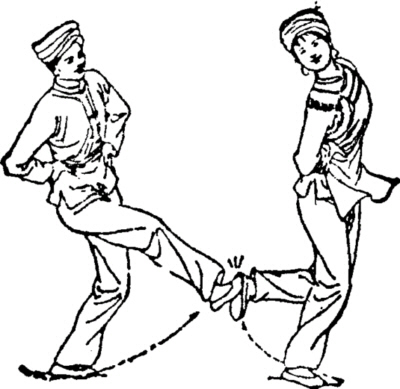
Figure 64 "Valley Chasing"
The Zhuang people have a famous "Bear Pole Dance" (also known as "Pile Driving Dance"), which originated from the work of pounding rice.The "Ling Biao Lu Yi" written by the people of the Tang Dynasty said: "There is a pounding hall in Guangnan, which uses Hunmu [kuku] as a trough. There are about ten pestles on both sides of a trough. Men and women stand alternately to pound rice. Knock the side of the trough. All have partial beats. The sound of the trough is like a drum, and it can be heard for several miles.” This rhythmic work of pounding rice and hitting the trough developed the ancient Zhuang traditional "Ban pole dance".Every new year, the Zhuang compatriots wear new clothes, and men and women stand opposite each other, holding wooden sticks, bumping each other, or knocking on wooden stakes, making different rhythms.

Figure 65 "Da Kick"

Figure 66 "Duhuo"

Figure 67 "Yo Scrims"
During the wedding ceremony of ancient Zhuang officials, there were ceremonial music and dances to show off their wealth and honor.
The Zhuang people also have folk dances such as "Emerald Bird" and "Partridge Bird" that imitate flying birds and symbolize auspiciousness.
The Dai nationality is a nation with a long history and cultural tradition, and has created its own writing, music and dance arts.The "Biography of Baiyi" written by Li Sicong and Qian Guxun in the early Ming Dynasty described the music and dance activities of Baiyi, the ancestors of the Dai people more than 500 years ago. The "Baiyi Biography" records that there are three kinds of music and dances to be played during the Baiyi banquet: one is "Da Baiyi Music", which mainly imitates the music of the Central Plains.The second is "Myanmar Music", which is a Burmese-style music and dance. Instruments include sheng, ruan, panxiao, konghou, pipa, etc. People clap their hands while singing and dancing.The third is "Happy in the Car".The car is equivalent to Xishuangbanna, Simao, Pu'er and other places in Yunnan today.Cheli music instruments use copper cymbals, bronze drums and castanets, and beat large and small long leather drums with hands.There is a folk custom of "beating big drums in villages, blowing Lusheng, and dancing for feast".That kind of scene is similar to that of beating gongs, beating drums with hands, and blowing calabash and sheng in today's Dai villages.The popularity of Dabaiyi music and Burmese music proves the historical fact of the cultural exchange of music and dance between Dai ancestors, Han people and neighboring Myanmar.

Figure 68 Chief Priest
Dai compatriots love beautiful peacocks.The images of peacocks are common in paintings and sculptures of the Dai people.Peacock decorations are also commonly seen on the daily utensils of the Dai people.The turban on the head of Dai men is fan-shaped at the end, symbolizing the opening of the peacock.The most representative national musical instrument of the Dai nationality, the elephant foot drum, has a few peacock feathers inserted at one end.There is also a national epic "Zhaoshutun and Nanmunona" among the Dai people, singing the story of the peacock princess.The Dai compatriots created the beautiful "Peacock Dance" a long time ago.There have been records about "Peacock Dance" during the Jiajing period of the Ming Dynasty.This dance is now famous both at home and abroad.There are also dances with ethnic characteristics such as "Red Deer Dance" among the Dai people.
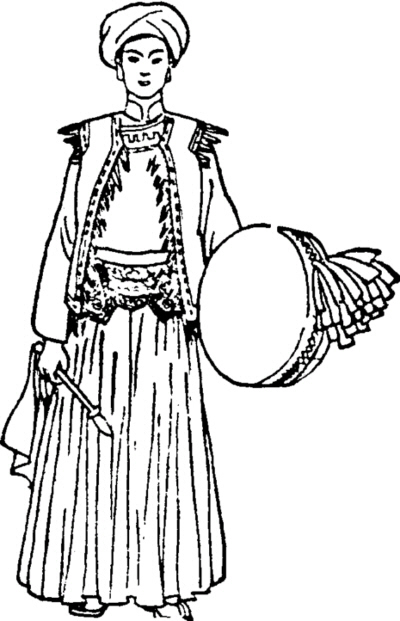
Figure 69 "Buzra" drummer
The Tujia people are descendants of the ancient Bayu people. "Waving Hand Dance" is an ancient dance popular among Tujia people.Beside any village where Tujia people live together, there is a small temple called "Waishou Hall".The "Earth King" is enshrined in the temple.When sacrificing to the earth king, the "Waving Hand Dance" is performed.When the Tujia people entered the hand-waving hall, someone led the singing and everyone sang together.Finally, young men and women sing and dance in front of the hall.The "Yongshun County Chronicles" written during the Qianlong period of the Qing Dynasty stated: "Every village has a hand-waving hall...every year from the third to the seventeenth day of the first lunar month, gongs and drums are played at night, men and women gather, dance and sing, and the name is "Wave Hands". ""Longshan County Chronicle" records "Waving Hands", men and women "wear five-flowered quilts, decorate handkerchiefs, beat drums and beat gongs, dance and sing for several nights." Hand waving'." Many dance movements of Tujia people waving hands have been lost. The existing "hand waving" movements of Tujia people in Hunan are mostly related to agricultural labor, such as threshing millet, beating straw sandals, beating cakes, planting corn, planting cotton, cutting millet, Pulling grass, planting seedlings, stepping on fields, drying grains, accumulating manure, sweeping the floor, spreading millet, burning card seeds, hemp, etc. In addition, there are hunting and fishing, blowing leaves, fighting cattle, picking up new girls, beating jiaozi, etc. More than 40 kinds.According to the size of Tujia "waving hands", there are "small waving hands" and "big waving hands". Thousands of people participated in the "big waving", men, women, old and young, carrying huge dragon and phoenix flags. Under the leadership of the "Tima" team of Tujia wizards wearing cassocks and law enforcement weapons, "Oh! The sound of "唩" is called to each other, and the guns and guns are fired together, and they march into the "Waiting Hall" in the wilderness.A prestigious "Tima" sang a sacrificial speech and led the crowd to bow down to the "eight kings".After the farewell, the huge dance team followed one after another, dancing "big hand waving".The long dance team winds and coils, layer upon layer, covering the valley.Amidst the sound of the bronze drum, the movements follow the "Tima" in a layered manner.Afterwards, people sang "Song of Waving Hands" and carried out military sports competitions such as "putting on armor", "queuing up", "catching poles" and "overturning ridges".The activity lasts for three days and nights, and the rituals and games change every day. "Waving Hands Dance" is divided into eight sections: "Let's Row to Drive", "Rushing into the Hall", "Commemorating the Eight Parts", "Brothers and Sisters Get Married", "Migration and Settlement", "Self-Defense Against the Enemy", "Drinking and Celebrating", "Send Driving to Sweep Hall".The song and dance performed in honor of the "Eight Great Kings" actually has the nature of a national epic.

Figure 70 "Buzira" dancing posture
There is also an even older dance of the Tujia people called "Maogusi". "Maogus" is an ancient man with long hair all over his body.The performers are naked and covered with grass.Wearing five "sweaters" woven from thatch or straw.In some places, there are several pieces of brown leaves or palm leaves, which are tied up on the body.This means the Tujia ancestors before civilization.There are several horns on the top of the performer's headgear, the even numbered horns represent cattle and animals, and the odd numbered horns represent humans.When performing, you must bend your knees slightly, sink your hips, and shake your whole body constantly, making the grass clothes rustle (si su xisu).The performers sang and talked, but they had to change their voices and make "weird sounds and strange airs".The content of the performance includes hunting, catching fish, making rice cakes, inviting Meishan gods, etc., showing productive labor and national reproduction, full of primitive atmosphere. "Maugus" is often performed while "waving hands".
Many ethnic groups in China are good at singing and dancing.The "Fan Dance" and "Drum Dance" by the Korean people on the banks of the Yalu River, the "Nongyue Dance" with "elephant hats" and dancing "elephant tails"; Flower hat dance" and so on, are national folk dances with a long history.
Chinese feudal dynasties, especially the rulers of the Yuan, Ming and Qing dynasties, have banned folk singing and dancing activities.However, with the help of the great power of folk custom inheritance, many of the songs and dances of various ethnic groups in China have been handed down to this day.After collation and adaptation, many folk dances have become excellent arts.Such as "Lion Dance", "Dragon Dance", "Red Silk Dance", "Peacock Dance", "Fan Dance", "Cup and Bowl Dance", "Flower Drum Lantern", "Grass Hat Dance", "Carrying the Bride", "Sheng Jingjian The Drum, etc., have won awards in international competitions and are well-known all over the world.From the colorful dance art of various ethnic groups, we are deeply aware of the profound tradition of Chinese national dance, and we can expect that people of all ethnic groups will decorate their beautiful life with more magnificent and splendid dances.

Figure 52 Xinjiang Uyghur Dance

Figure 53 "Zhuo" dancing posture

Figure 54 "Reba" dancing posture

①Gold ②White ③Black ④Red Nixie

①Gold-plated ②White ③Red ④Gold-plated Russian one Figure 55 Example of "Qiangmu" mask

Figure 56 Example of "Qiangmu" dance posture

Figure 57 Cup and Bowl Dance

Figure 58 "Bo"

Figure 59 "Chama" dancing posture

Figure 61 Eri Moche

Figure 62 "Lusheng Dance" of the Miao Nationality in the Qing Dynasty (taken from "Guangyu Shenglan")

Figure 63 "Suniqie"

Figure 64 "Valley Chasing"

Figure 65 "Da Kick"

Figure 66 "Duhuo"

Figure 67 "Yo Scrims"

Figure 68 Chief Priest

Figure 69 "Buzra" drummer

Figure 70 "Buzira" dancing posture
